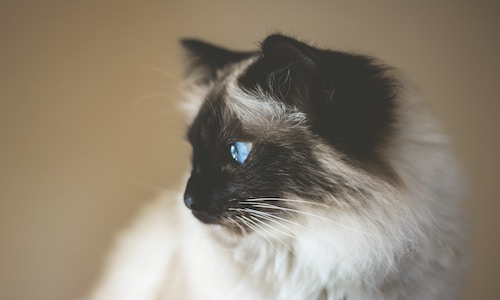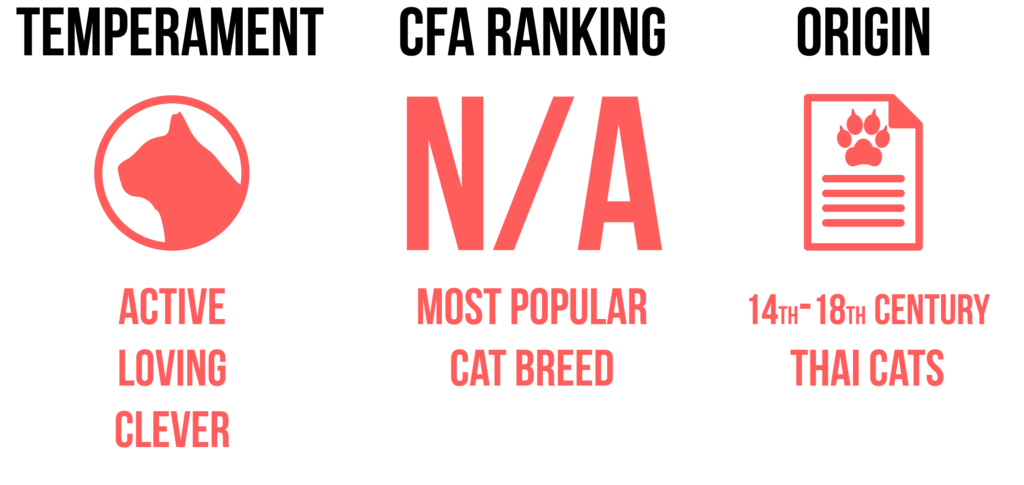
The Siamese cat breed is all set for a masquerade ball with pale evening wear and striking dark accessories on its face, ears, paws, and tail. It’s a beautiful, talkative feline that is highly intelligent and craves the attention of its family. The Siamese is a busy-body and will follow its owners around the house, taking every opportunity to be with them. Keeping this kitty occupied is important to keep it out of mischief. If you don’t mind a chatter-box, the Siamese is perfect for someone who wants a fun, affectionate, social cat.
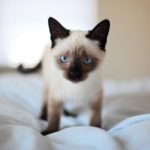
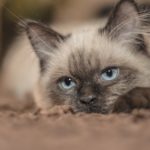

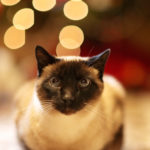
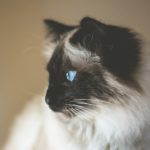
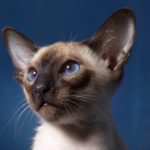
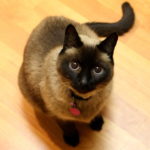
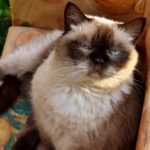
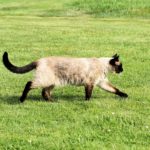
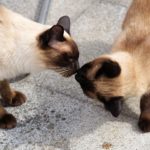
Did You Know…?
- The Siamese cat hails from Thailand (formerly Siam). Their unique appearance and interesting disposition was adored by royalty there and it was believed that when a member of the royal family died, a Siamese cat would receive their soul. The cat would then be moved to a temple to spend the rest of its life living in luxury with monks and priests to wait on it.
- The first Siamese cat that came to the United States was given to President Rutherford B. Hayes’ wife, Lucy, as a gift. It was given in 1878 by David B. Sickels, a U.S. diplomat at the consul in Thailand. The cat “Siam” soon became a favorite of their daughter Fanny and was given free rein of the White House. Siamese cats were also in residence at the White House during Gerald Ford’s and Jimmy Carter’s presidencies.
- There are two types of Siamese cat. The first is called the show-style or Modern Siamese and has long, angular features, with a wedge-shaped head and large ears. The second is the traditional, or apple-headed, Siamese. It has a more conservative appearance with a rounded head and thicker body. Both types of Siamese have the signature blue eyes and point-colored coat.
- The Siamese cat is known for its voice and is not afraid to speak up. It can spend all day and all night vocalizing its opinion about what it’s eating, what you are doing, whether you are giving it enough attention or not, what it sees out the window, and anything else you can possibly imagine. If you want to add this cat to your household, expect a chatterbox.
- Siamese cats are known for their point-colored coats. This refers to their light-colored coat with darker colors on the “points” of its body, meaning the face, ears, feet, and tail. Their coloring is natural, meaning the point-pattern was the result of a genetic mutation. The typical colors for the points are seal, lilac, chocolate, and blue, but they could also be tabby, red, cream, silver or smoke.
- There are many myths surrounding the Siamese breed. Two in particular are said to explain some of this cat’s fascinating characteristics. One story tells how sacred Siamese temple cats, charged with guarding a valuable vase, curled their tails around the vase and stared at it with such intensity that their eyes became crossed. Another tells of Siamese cats chosen to guard a princess’ rings: the cats kept the rings on their tails and the tail kinks developed to keep the rings from sliding off.
- Siamese cats are very needy and crave time, attention, and companionship. They are very social cats and need to be actively involved in any task that you’re doing and will follow you from room to room. This breed does best in a house where someone is home more often than not. It can actually become sad and lonely if left alone for too long.
- Siamese cats have been loved by many royal family members and celebrities over the years. Queen Victoria was reportedly fond of the breed, and Queen Elizabeth II was given a Siamese kitten as a wedding present upon her marriage to Prince Philip. Elizabeth Taylor owned several Siamese cats, and she gave one named Marcus as a gift to James Dean. Vivien Leigh was a big lover of the breed as well, owning many Siamese cats throughout her life. One of her favorites, Poo Jones, traveled constantly with the actress and was with her when she died. Several other famous people that had Siamese cats include John Lennon, Paul Newman, Cary Grant, and Ava Gardner.
- The same gene that is responsible for the Siamese cat’s unique point-colored coat also restricts the amount of pigment found in the eye, resulting in the signature blue eyes that the breed is known for.
- All Siamese kittens are born completely white. It’s not until they are about 4 weeks old when the heat-sensitive gene that is responsible for their point-colored coats is activated and the coldest parts of their bodies, or the “points,” turn a darker color.
- Siamese cats used to have crossed-eyes and kinked tails, but cat fanciers viewed these traits as undesirable, and gradually eliminated them via selective breeding.
- In the movie That Darn Cat, the main cat was a seal point Siamese named Syn. He was left at an animal shelter because he was deemed too “standoffish,” and was later adopted by an animal trainer for $5. Syn was the first cat to win a PATSY award, an honor granted to animal performers by the Hollywood office of the American Humane Association. (Due to a lack of funding, the PATSY Awards were discontinued in 1986.)
- Siamese cats have one of the longest life expectancies when it comes to domestic breeds, with indoor Siamese cats living up to 20 years.
- In the 1960s there were two Siamese cats at the Dutch Embassy in Moscow, Russia, that were asleep in then-ambassador Henri Helb’s study. Suddenly they woke up and began arching their backs and clawing at a wall. Helb suspected that the agitated cats heard a noise that didn’t register with the human ear. He instigated an investigation that revealed 30 tiny microphones hidden behind the wall. Instead of calling out the Russian government’s espionage, Helb and his staff decided to use it to their advantage. Lingering in front of the microphones, they strategically complained about delays in embassy repairs or packages that got stuck in customs. Within 24 hours, these problems would mysteriously become resolved.
- On August 7, 1970, a Burmese/Siamese cat in Oxfordshire, U.K., gave birth to 19 kittens, though four were sadly stillborn. This was incredible considering the fact that Siamese cats typically only have four to six babies. The massive brood was recorded as the world’s largest litter of domestic cats and remains so to this day.
- When Siamese cats were first shown in London’s Crystal Palace Cat Show in 1871 they were described as ‘an unnatural nightmare kind of cat’ because of their strange coloring. They went on to become one of the most popular cat breeds in the world!
- In Thailand, Siamese cats are called the wichien-matt, which is roughly translated to “Moon Diamond.”
- It’s quite possible to train Siamese cats. They are extremely intelligent and enjoy the challenge. They can be trained to walk on a leash, do simple tricks, and even play fetch.
- It is quite possible to train a Siamese cat – due to their intelligent nature they even enjoy it. They can be trained to fetch and retrieve, walk on a harness, and even do tricks.
- It’s not uncommon for Siamese cats to be lactose intolerant, or unable to digest lactose, a sugar found in milk and dairy products. This is the case for other Oriental cats as well. Milk should not be given to Siamese cats as it can cause bad diarrhea—if you choose to experiment with dairy products, do so with caution.
- Due to its popularity, the Siamese has contributed to the creation of many other breeds. Some of these breeds include the Ocicat, Burmese, the Himalayan division of the Persian, the Tonkinese, Korat, Snowshoe, Havana Brown, and a plethora of Oriental breeds such as the Oriental Shorthair, Oriental Longhair, Colorpoint Shorthair, Colorpoint Longhair, Balinese, and Javanese.
Breed Characteristics
Quick Stats:
- Weight: 8-15 pounds
- Lifespan: 11-15 years
Social Needs

Independence

Affectionate with Family

Kid Friendly

Pet-Friendly

Stranger-Friendly

Energy Level

Potential for Playfulness

Adaptability

General Health

Intelligence

Tendency to Vocalize

Easy to Groom

Amount of Shedding

History
The Siamese cat is originally from Thailand (formerly known as Siam) and was adored by royalty due to its interesting appearance and disposition. It’s believed that when a member of the royal family died, their Siamese cat would receive their soul. The cat would then be moved to a temple where they spent the rest of their lives in luxury, being waited on by monks and priests.
Other myths try to explain some of this cat’s fascinating characteristics. One story tells how sacred Siamese temple cats, charged with guarding a valuable vase, curled their tails around the vase and stared at it with such intensity that their eyes became crossed. Another tells of Siamese cats appointed to guard princesses’ rings: The cats kept the rings on their tails and the tail kinks developed to keep the rings from sliding off.
The Siamese also made it into the Cat Book of Poems, a manuscript written in the city of Ayudha (the ancient capital of Siam) sometime between 1350 when the city was founded and 1767 when the city was burned by invaders. Illustrations and descriptions describe a slim cat with a pale coat and dark coloring on its ears, tail, and feet.
The beautiful light-colored cat with the striking color points made its Western Hemisphere debut in Victorian England at London’s Crystal Palace Cat Show in 1871. It was publicized as the Royal Cat of Siam (Thailand today) but received a dismal reception. The attendees were said to have been disgusted with “an unnatural, nightmare kind of cat.”
Despite the dismal start, the Siamese cat breed quickly gained popularity and became fashionable pets. At that time, the Siamese were noted for their crossed eyes and kinked tails; these didn’t become conformation faults until later.The first British Standard—an abstract aesthetic ideal for the animal type—describes the Siamese as a “striking-looking cat of medium size, if weighty, not showing bulk, as this would detract from the admired svelte appearance … also distinguished by a kink in the tail.”
In 1884 a breeding pair of Siamese cats named Pho and Mia was brought to the UK by the British Consul-General in Bangkok as a gift for his sister. The breed soon spread to other parts of Europe and Asia and appeared in English cat shows almost immediately. It found its way to American shows by the early twentieth century. The first English Siamese cat fancier’s club was formed in 1902.
The breed became popular in the United States several years before it started showing up in American cat shows. In 1878, David B. Sickels, a U.S. diplomat stationed at the consulate in Thailand, sent a Siamese cat to Lucy Hayes, wife of President Rutherford B. Hayes. A letter from Sickels detailing the gift is on file at the Rutherford B. Hayes Presidential Center in Fremont, Ohio. In April of 1909, the first Siamese Cat Society of America was formed.
At first, only the cats with seal points—a dark brownish-black—were shown in the ring, but blue, chocolate and lilac-point Siamese were soon developed and are accepted today. Now Siamese cats come in many different point colors and patterns, including tabby points and smoke points. The Siamese remained somewhat rare until after World War II when they quickly became number one in terms of registrations.
Some of the breed’s front-and-center moments include representation in movies such as “The Incredible Journey,” “The Aristocats” and “Lady and the Tramp.” Today the Siamese is one of the most popular cat breeds registered by the Cat Fanciers Association.
The Siamese itself is a natural breed, meaning its original pointed pattern was the result of a genetic mutation, but, due to its popularity, it has contributed to the creation of many other breeds. Some of these breeds include the Ocicat, Burmese, the Himalayan division of the Persian, the Tonkinese, Korat, Snowshoe, Havana Brown, and a plethora of Oriental breeds such as the Oriental Shorthair, Oriental Longhair, Colorpoint Shorthair, Colorpoint Longhair, Javanese, and Balinese cat.
The Siamese is recognized by all cat associations. The International Cat Association also recognizes the Thai (also known as the traditional Siamese) and is described as the original form of the native pointed cat of Thailand. In Thailand, these cats are called Wichienmaat. Some people refer to it as an old-style Siamese. It shares the pointed coat and dictatorial personality of the Siamese but has a more moderate body type, with a rounded head and a chunky body.
Size
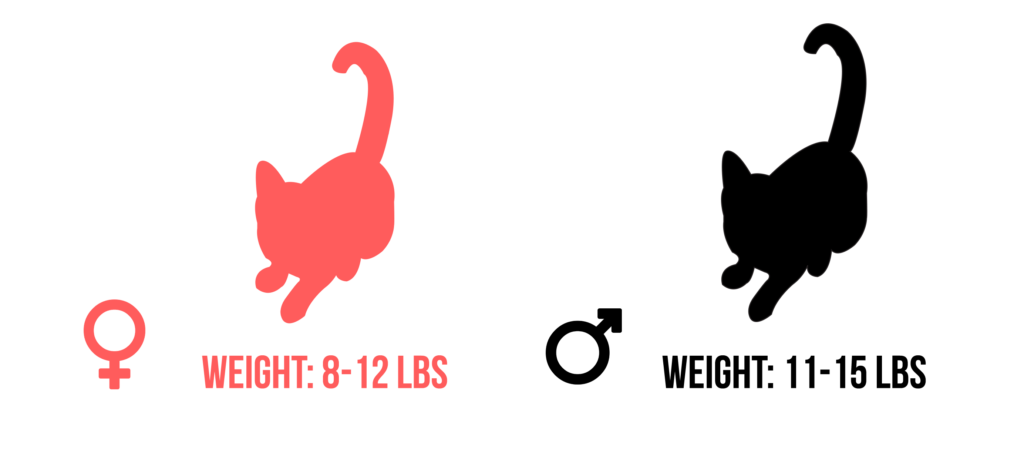 The Siamese cats are medium sized with the males weighing between 11 and 15 pounds and the females weighing between 8 and 12 pounds.
The Siamese cats are medium sized with the males weighing between 11 and 15 pounds and the females weighing between 8 and 12 pounds.
Appearance
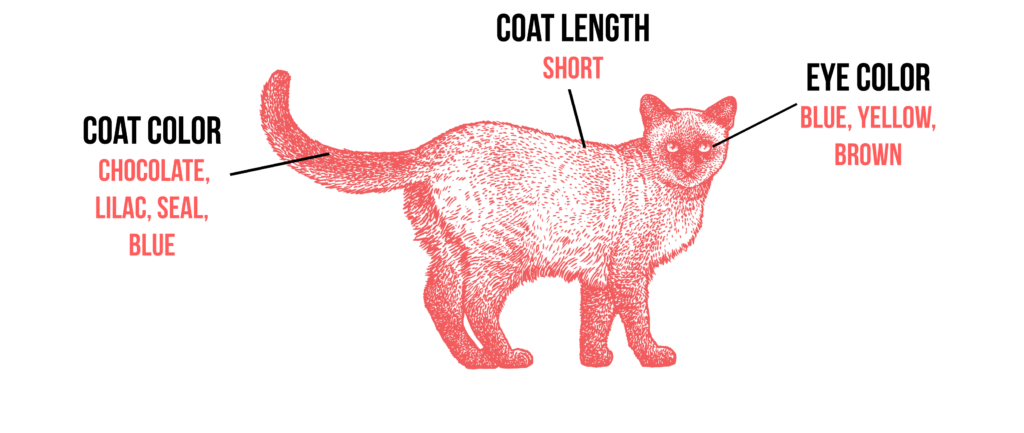 Perhaps the most captivating feature of the Siamese cat is the eyes—they are always medium-sized, almond-shaped, and a vivid blue.
Perhaps the most captivating feature of the Siamese cat is the eyes—they are always medium-sized, almond-shaped, and a vivid blue.
Over the course of the years, the Siamese cat has been assigned three body types. The first type is called the applehead Siamese, or traditional Siamese cat. It most resembles the first cats exported from Siam (now Thailand) and has a round face and a rounded, big-boned, muscular body. The Coat for both the Traditional Siamese and the Classic Siamese (below) is basically the same. It’s short, and somewhat thick, and is soft to the touch.
The second body type has been called the moderate, old-style or classic Siamese, referring to the look of the cats that were popular in the ’50s, ’60s, and ’70s. They are sometimes called the Thai cat as well. This body type is similar to the Apple-headed Siamese in that it is also large-boned, but it has a longer, slimmer body, and a more wedge-shaped head. They also have finer, more triangular faces—though nowhere near as extreme as those found in the modern Siamese. It also has medium-length, graceful legs that are supported by medium-sized oval-shaped paws. Its tail is as long as the torso and tapers at the tip.
That brings us to the third body type: the “show-style,” or modern Siamese cat. These cats are slight, fine-boned, and long and thin all over. They have long thin bodies, necks, and tails and have a sharply triangular, wedge-shaped head with large ears. They also have longer muzzles and a straighter nose than the two previous body types. They walk on small, dainty, oval paws and their coat is short and fine.
Often it’s difficult distinguishing between the classic and traditional Siamese. Since every cat is different you’ll find cats everywhere on the spectrum from the round-headed traditional Siamese cat to the long and angular modern Siamese. Breed standards merely offer a guideline to help categorize the different body types.
The Siamese cat breed has the same general color standards, regardless of body type. All coats should have a lighter colored body with darker “points” on the ears, feet, tail, and mask (on the face). The acceptable color of the points differs depending on the breed standard of each organization.
The Cat Fancier’s Association (CFA) recognizes seal point, a pale fawn to cream body with dark seal brown (almost black) points and dark brown paw pads and nose; chocolate point, an ivory body with milk chocolate-colored points and a cinnamon-pink colored nose and paw pads; blue point, a bluish-white body with deep blue points and a slate-colored nose and paw pads; and lilac point, a glacial white body with frosty pinkish-gray points and a lavender-pink nose and paw pads.
The International Cat Association (TICA) allows for a broader range of colors beyond the four point colors recognized by the CFA. Approved colors also include tabby points, red points, cream points, silver tabby points, smoke points and particolor points.
The Traditional Cat Association, Inc. (TCA Inc.) recognizes the same colored coats as the CFA but also includes albino coloring.
Behavior
Intellect
The Siamese breed is highly intelligent, but that doesn’t mean they can be trained to do everything you want. Like other highly intelligent breeds, the Siamese have their own desires. Keep their busy brains active with puzzle toys and their active bodies exercised.
Personality
The Siamese cat personality is loud and proud. Siamese cats are extremely outgoing and are known for their talkative natures. They are not afraid to comment on how much (or how little) attention you are giving them. Not a talker yourself? No problem. They’ll keep a monologue going with that raspy voice of theirs for your enlightenment. So if you don’t mind having a talkative busybody by your side all day, this could be the breed for you.
Your Siamese will also “supervise” your work throughout the day. They are extremely social cats and need time and attention from the people they adore. They are known as the eternal kitten—the cat that never grows up. They display a more social personality than other breeds, even in the presence of other domestic animals. At night you can even find them snuggled up under your covers and hogging part of the pillow.
Since this breed is highly intelligent, agile, playful and active, it’s important that you keep them occupied with teaser toys, puzzle toys, a bird feeder outside their window, a ball that they can fetch for you, and/or a big cat tree. When bored or unoccupied, don’t be surprised when your Siamese gives toilet paper and tissue boxes a makeover or finds new and exciting hiding places to disappear to when people are looking for him.
Sometimes Siamese cats will act aloof, but it’s all an act! They need to be treated with respect and patience and require lots of affection to develop a close relationship with their people. Siamese will pine if left alone too often.
Children & Other Pets
The Siamese does great with children and cat-friendly dogs. Due to its active nature, the Siamese can play fetch as well as any dog, loves to learn tricks, and adores (gentle and respectful) attention from doting children. It’s even recommended that you have a second cat to keep your Siamese company if you’re gone a lot during the day. However, the Siamese are dominant in their relationships with other cats.
Health
 A lot of people know about the kinked tails and crossed eyes that used to plague the Siamese breed, but those defects have all but been eliminated due to careful breeding. With that in mind, run from any breeder who does not offer a health guarantee on kittens or who tells you that the breed is 100 percent healthy and has no problems. There are, in fact, a few genetic health problems that may affect the Siamese.
A lot of people know about the kinked tails and crossed eyes that used to plague the Siamese breed, but those defects have all but been eliminated due to careful breeding. With that in mind, run from any breeder who does not offer a health guarantee on kittens or who tells you that the breed is 100 percent healthy and has no problems. There are, in fact, a few genetic health problems that may affect the Siamese.
Amyloidosis
This is a destructive disease that occurs when a protein called amyloid is deposited in certain organs in your body. For the Siamese, it’s usually in the liver.
Asthma/Bronchial Disease
Feline asthma is an inflammatory disorder of the small passageways of a cat’s lungs that causes a daily cough. This cough can possibly be caused by the lungs discharging mucus into the airways. Some cats with milder cases only experience a slight, chronic cough.
Congenital Heart Defects
Most heart defects are diagnosed in cats who are middle-aged or older, though rarely kittens can be diagnosed early on. The Siamese breed is at an increased risk for cardiomyopathy, a condition where the muscles of the heart become unable to perform their proper function which may lead to heart failure. Another heart defect that is present at birth is aortic stenosis, a condition where the aortic valve is abnormally narrow, restricting blood outflow to the rest of the body.
Dental Problems
Siamese cats are at risk for gingivitis, a condition where pockets of plaque remain in the mouth for too long and release toxins that irritate the gums. The best way to prevent this is to brush your cat’s teeth on a regular basis.
Maintenance
Care
Keep this treasured cat indoors to protect it from disease, attacks by other animals such as dogs or coyotes, and other dangers like being hit by a car. Letting them outside also runs the risk of them being stolen by someone who would like to have such a gorgeous cat without paying for it.
Providing neutering or spaying as appropriate and acceptable surfaces (like a scratching post) for the natural behavior of scratching are essential elements for maintaining a healthy, long, and joyful life with your Siamese.
Feeding
Weight gain will show quickly in the Siamese, especially the Modern or “Show-style” Siamese. Some cats can control their appetite and others may eat every meal like their life depended on it. Resist the temptation to overfeed them. Their nutrition should be strictly regulated. Their slim legs were not meant to hold a fat body.
Grooming
This breed’s short, fine coat can be easily taken care of by brushing it once a week to remove dead hairs and distribute natural oils. Because the Siamese are at risk for periodontal disease, brush their teeth regularly. If you can’t every day, do so at least once a week. Trim the nails as needed, about every 10-14 days.
Commonly Asked Questions
What kind of Siamese cat do I have?
The kind of Siamese you have depends on the body shape. The show-style, or modern, Siamese is angular, long, slender, has a super short, fine coat, a wedge-shaped head and large ears. Those with a more conservative face, more rounded bodies, and regular-sized ears are considered traditional Siamese. All Siamese have blue eyes, a pointed coat, and are very talkative.
What Siamese cats like to do?
Siamese cats are extremely outgoing and love being with their people. They enjoy “supervising” their owner’s activities and thrive on time and attention. they are a highly intelligent, agile, playful breed that needs toys and activities (such as teaser toys, puzzle toys, a ball to play fetch, a big cat tree, or a bird feeder outside their favorite window) to keep them occupied. When bored or unoccupied, don’t be surprised when your Siamese gives toilet paper and tissue boxes a makeover or finds new and exciting hiding places to disappear to when people are looking for him.
Do Siamese cats usually have blue eyes?
Yes, all Siamese cats have blue eyes. It is one of the distinguishing features of the breed.
Resources
Rescue Organizations/Groups
- Purebred Cat Breed Rescue
- Rescue Me
- Siamese Rescue
- Siamese Cat Rescue Center
- Rocky Mountain Siamese Rescue
- Pacific Siamese Rescue
- Southern California Siamese Rescue
Breed Organizations
- National Siamese Cat Club
- Cat Fanciers’ Association, Inc.
- The International Cat Association
- American Cat Fanciers Association
